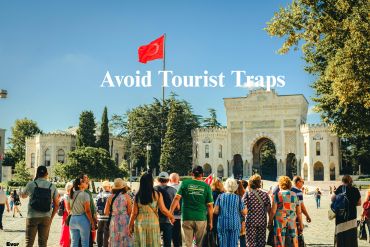Tourist traps are everywhere—from the overpriced souvenir shops near iconic landmarks to restaurants that serve bland food at inflated prices. If you’ve ever felt like you paid too much for an underwhelming experience, you’re not alone. The good news is that with a bit of insider knowledge and preparation, you can sidestep the crowds, dodge the scams, and enjoy authentic experiences that don’t drain your travel budget.
This guide reveals local secrets to eat, shop, and explore without falling for tourist traps, so you can travel smarter and more affordably.
What Is a Tourist Trap and Why Should You Avoid It?
A tourist trap is a location, attraction, or business that targets tourists with high prices, generic experiences, and low-quality offerings. While they may be conveniently located near popular destinations, they rarely reflect the local culture and usually deliver less value than hidden alternatives.
Common features include:
- Inflated prices
- Aggressive marketing
- Inauthentic products or food
- Long lines and crowds
- Lack of local customers
Avoiding them allows you to experience a place more like a local, saving money while enjoying richer, more meaningful travel moments.
Eat Like a Local: Skip the Menu Boards in English
1. Seek Out Side Streets, Not Main Squares
Restaurants near major tourist sites often charge double for half the quality. Walk just 3 to 5 blocks away and the difference is dramatic. You’ll find:
- Lower prices
- More authentic recipes
- Restaurants frequented by locals
Tip: Look for handwritten menus, daily specials, or chalkboards with prices listed in the local currency—signs that it caters to residents, not tourists.
2. Visit Local Markets and Food Halls
In cities from Bangkok to Barcelona, food markets are where locals actually eat. You can try authentic dishes made from fresh ingredients for a fraction of what you’d pay in a restaurant near a landmark.
Examples:
- La Boqueria, Barcelona: Tapas and jamón from locals-only stalls
- Nishiki Market, Kyoto: Street food and pickles prepared by third-generation vendors
- Mercado de San Juan, Mexico City: Gourmet tacos, mole, and native spices
3. Ask Locals, Not Your Hotel Concierge
Locals know what’s good—and affordable. While hotel staff may steer you toward tourist-friendly options, ask:
- Bartenders
- Ride-share drivers
- Street vendors
- Cashiers at local stores
These people usually give honest suggestions that reflect where they actually eat.
Shop Smart: Where to Find Quality Without the Tourist Prices
1. Avoid Shops Directly Outside Attractions
That souvenir shop next to the Colosseum or the Eiffel Tower might look tempting, but chances are you’re paying 3 to 5 times the value of the same product found elsewhere.
2. Visit Artisan Markets or Neighborhood Boutiques
Look for:
- Handcrafted goods
- Local artists and designers
- Co-ops or fair-trade stalls
Not only will you support local makers, but you’ll also bring home items with a story behind them—not mass-produced replicas.
3. Time Your Shopping
Many cultures offer discounts at specific times:
- End of market days (vendors may drop prices to clear inventory)
- Local holidays or festivals (pop-up stalls with discounted goods)
- Off-season sales in fashion districts
Plan your shopping time carefully, and you’ll get better value without sacrificing authenticity.
Explore Like a Local: Discover Hidden Gems and Free Attractions
1. Use Local Transit, Not Sightseeing Buses
Public transportation is often reliable, cheap, and the best way to get around cities like:
- Berlin, with its efficient U-Bahn and trams
- New York City, where subways reach almost every borough
- Tokyo, where trains connect you to lesser-known neighborhoods with local charm
Plus, taking the bus or metro gives you a chance to people-watch and discover new spots along the way.
2. Follow Local Event Calendars and Community Boards
Cities often host free or low-cost events that don’t make it into travel brochures. Check:
- Local tourism websites
- Facebook event pages
- Community bulletin boards in cafés or libraries
You might stumble upon free concerts, art walks, food festivals, or cultural celebrations.
3. Join Free Walking Tours or Self-Guided Apps
Free walking tours are run by passionate locals who work for tips. You’ll hear real stories and visit neighborhoods rarely mentioned in guidebooks.
Self-guided apps like GPSmyCity or Rick Steves Audio Europe offer offline maps and audio guides, letting you tour at your pace while avoiding crowds.
How Locals Avoid the Crowds: Smart Timing and Location
1. Visit Early or Late in the Day
Iconic sights are often less crowded and cheaper to visit right when they open or just before closing. This trick also gives you better light for photos and a more relaxed experience.
2. Explore Less-Touristy Neighborhoods
Every city has its cool, up-and-coming neighborhoods that haven’t been flooded with tourists yet. Try:
- Bushwick, Brooklyn instead of Times Square
- Shoreditch, London instead of Piccadilly Circus
- Gràcia, Barcelona instead of La Rambla
Here you’ll find local cafés, independent galleries, and lively bars where prices are lower and authenticity is higher.
Practical Apps to Avoid Tourist Traps
1. Google Reviews and Maps
Use map-based searches to find spots with high ratings from locals. Pay attention to:
- Reviews written in the local language
- Comments about pricing or authenticity
- How long people spend there
2. Spotted by Locals
An app and website filled with insider city guides written by locals. It skips tourist clichés and helps you discover places off the beaten path.
3. Meetup and Eventbrite
Find local events, workshops, or experiences hosted by people in the community—often free or donation-based.
4. EatWith or WithLocals
These platforms connect travelers with local hosts for home-cooked meals, food tours, or classes, providing a rich cultural experience away from the crowds.
Don’t Be Afraid to Get Lost—Just Be Smart
Some of the most memorable travel moments happen when you wander away from the guidebooks. While it’s important to stay aware and safe, exploring lesser-known areas opens the door to genuine cultural experiences.
Here’s how to do it safely:
- Download offline maps before you go
- Let someone know your general location
- Stay in well-lit, populated areas
- Trust your instincts—if something feels off, move on
Final Thoughts: Authentic Travel Doesn’t Cost More—It Costs Less
Avoiding tourist traps isn’t just about spending less money. It’s about getting more for your time and budget. By eating where locals eat, shopping where locals shop, and exploring neighborhoods that tell real stories, you’ll connect more deeply with your destination—and avoid the overpriced, underwhelming experiences that tourists fall into.
The best part? These local secrets usually cost less, offer better quality, and leave you with stories you can’t buy in a gift shop.
In another related article, How to Share Your Real-Time Location Safely with Friends and Family (2025 Guide)







